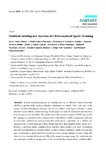Mostrar o rexistro simple do ítem
Ambient Intelligence Systems for Personalized Sport Training
| dc.contributor.author | Vales-Alonso, Javier | |
| dc.contributor.author | López-Matencio, Pablo | |
| dc.contributor.author | González-Castaño, Francisco Javier | |
| dc.contributor.author | Navarro-Hellín, Honorio | |
| dc.contributor.author | Baños-Guirao, Pedro J. | |
| dc.contributor.author | Pérez-Martínez, Francisco J. | |
| dc.contributor.author | Martínez-Álvarez, Rafael P. | |
| dc.contributor.author | González-Jiménez, Daniel | |
| dc.contributor.author | Gil-Castiñeira, Felipe | |
| dc.contributor.author | Duro, Richard J. | |
| dc.date | 2010 | |
| dc.date.accessioned | 2017-04-26T07:50:02Z | |
| dc.date.available | 2017-04-26T07:50:02Z | |
| dc.date.issued | 2010 | |
| dc.identifier.citation | Sensors 2010, Vol. 10, Pages 2359-2385 | es_ES |
| dc.identifier.issn | 1424-8220 | |
| dc.identifier.uri | http://hdl.handle.net/2183/18447 | |
| dc.description.abstract | Several research programs are tackling the use of Wireless Sensor Networks (WSN) at specific fields, such as e-Health, e-Inclusion or e-Sport. This is the case of the project “Ambient Intelligence Systems Support for Athletes with Specific Profiles”, which intends to assist athletes in their training. In this paper, the main developments and outcomes from this project are described. The architecture of the system comprises a WSN deployed in the training area which provides communication with athletes’ mobile equipments, performs location tasks, and harvests environmental data (wind speed, temperature, etc.). Athletes are equipped with a monitoring unit which obtains data from their training (pulse, speed, etc.). Besides, a decision engine combines these real-time data together with static information about the training field, and from the athlete, to direct athletes’ training to fulfill some specific goal. A prototype is presented in this work for a cross country running scenario, where the objective is to maintain the heart rate (HR) of the runner in a target range. For each track, the environmental conditions (temperature of the next track), the current athlete condition (HR), and the intrinsic difficulty of the track (slopes) influence the performance of the athlete. The decision engine, implemented by means of (m; s)-splines interpolation, estimates the future HR and selects the best track in each fork of the circuit. This method achieves a success ratio in the order of 80%. Indeed, results demonstrate that if environmental information is not take into account to derive training orders, the success ratio is reduced notably. | es_ES |
| dc.description.sponsorship | Ministerio de Educación y Ciencia; DEP2006-56158-C03-01/02/03 | es_ES |
| dc.description.sponsorship | Ministerio de Educación y Ciencia; TEC2007-67966 -01/02/TCM CON-PARTE-1/2 | es_ES |
| dc.description.sponsorship | Ministerio de Industria, Turismo y Comercio ; TSI-020301-2008-16 ELISA | es_ES |
| dc.description.sponsorship | Ministerio de Industria, Turismo y Comercio ; TSI-020301-2008-2 PIRAmIDE | es_ES |
| dc.language.iso | eng | es_ES |
| dc.publisher | Molecular Diversity Preservation International | es_ES |
| dc.relation.uri | http://dx.doi.org/10.3390/s100302359 | es_ES |
| dc.rights | Reconocimiento 3.0 | es_ES |
| dc.rights.uri | http://creativecommons.org/licenses/by/3.0/ | |
| dc.subject | Ambient intelligence | es_ES |
| dc.subject | Contextual services | es_ES |
| dc.subject | Wireless sensor networks | es_ES |
| dc.subject | Sport training | es_ES |
| dc.subject | Machine learning | es_ES |
| dc.title | Ambient Intelligence Systems for Personalized Sport Training | es_ES |
| dc.type | info:eu-repo/semantics/article | es_ES |
| dc.rights.access | info:eu-repo/semantics/openAccess | es_ES |
| UDC.journalTitle | Sensors | es_ES |
| UDC.volume | 10 | es_ES |
| UDC.issue | 3 | es_ES |
| UDC.startPage | 2359 | es_ES |
| UDC.endPage | 2385 | es_ES |
Ficheiros no ítem
Este ítem aparece na(s) seguinte(s) colección(s)
-
CIT-GII - Artigos [38]






